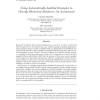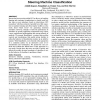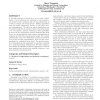4128 search results - page 77 / 826 » Learning and using relational theories |
NLE
2008
13 years 10 months ago
2008
Being able to identify which rhetorical relations (e.g., contrast or explanation) hold between spans of text is important for many natural language processing applications. Using ...
UM
2007
Springer
14 years 4 months ago
2007
Springer
Accurately recognizing users’ affective states could contribute to more productive and enjoyable interactions, particularly for task-oriented learning environments. In addition t...
AAAI
1998
13 years 11 months ago
1998
Weadvance a knowledge-based learning method that augments conventional generalization to permit concept acquisition in failure domains. These are domains in whichlearning must pro...
CHI
2010
ACM
14 years 4 months ago
2010
ACM
Interest has been growing within HCI on the use of machine learning and reasoning in applications to classify such hidden states as user intentions, based on observations. HCI res...
GECCO
2005
Springer
14 years 3 months ago
2005
Springer
A powerful approach to search is to try to learn a distribution of good solutions (in particular of the dependencies between their variables) and use this distribution as a basis ...



